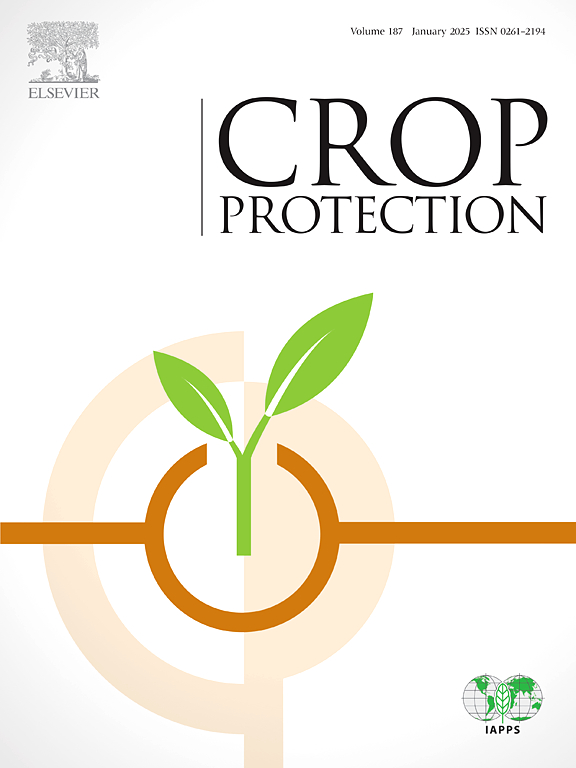Jute under siege: A deep dive into stem rot disease caused by Macrophomina phaseolina (Tassi) Goid.
IF 2.5
2区 农林科学
Q1 AGRONOMY
引用次数: 0
Abstract
Jute stem rot disease, caused by Macrophomina phaseolina, presents a multifaceted challenge to jute cultivation. While diseases caused by this pathogen have been reviewed extensively in several other crops, a dedicated examination of its impact on jute (Corchorus capsularis and C. olitorius) is long overdue. Continued research and innovation in disease management will be crucial for ensuring the prosperity of this important fibre crop. We present here various aspects of the jute stem rot disease, including its history, epidemiology, molecular basis of host resistance and multipronged management strategies. One of the key takeaways from this review is the importance of host resistance. Although jute lines with complete resistance to JSR are yet to be identified, several moderately resistant cultivars have shown promise in reducing disease incidence. The review underscores the value of emerging areas of research viz. nano-pesticides, genetic engineering in developing an integrated disease management approach for jute stem rot. Based on the current knowledge, we propose a model for the interaction between jute and M. phaseolina that aims to shed light on the dynamic relationship between them. As the agricultural landscape continues to evolve, the insights and strategies discussed in this review provide a foundation for sustainable and resilient jute cultivation in the face of challenges posed by stem rot disease.
身陷囹圄的黄麻:深究由黄麻大霉病(Tassi)引起的茎腐病。
由黄麻茎腐病(Macrophomina phaseolina)引起的黄麻茎腐病给黄麻种植带来了多方面的挑战。虽然这种病原体引起的病害已在其他几种作物上广泛报道,但对其对黄麻(Corchorus capsularis 和 C. olitorius)影响的专门研究却迟迟没有进行。病害管理方面的持续研究和创新对于确保这一重要纤维作物的繁荣至关重要。我们在此介绍黄麻茎腐病的各个方面,包括其历史、流行病学、宿主抗性的分子基础和多管齐下的管理策略。本综述的主要结论之一是宿主抗性的重要性。虽然对 JSR 具有完全抗性的黄麻品系尚未确定,但一些具有中等抗性的栽培品种已显示出降低病害发生率的前景。本综述强调了纳米杀虫剂、基因工程等新兴研究领域在开发黄麻茎腐病综合病害管理方法方面的价值。基于现有知识,我们提出了黄麻与相思豆之间的相互作用模型,旨在阐明两者之间的动态关系。随着农业格局的不断演变,本综述中讨论的见解和策略为黄麻种植在面对茎腐病带来的挑战时实现可持续发展和恢复能力奠定了基础。
本文章由计算机程序翻译,如有差异,请以英文原文为准。
求助全文
约1分钟内获得全文
求助全文
来源期刊

Crop Protection
农林科学-农艺学
CiteScore
6.10
自引率
3.60%
发文量
200
审稿时长
29 days
期刊介绍:
The Editors of Crop Protection especially welcome papers describing an interdisciplinary approach showing how different control strategies can be integrated into practical pest management programs, covering high and low input agricultural systems worldwide. Crop Protection particularly emphasizes the practical aspects of control in the field and for protected crops, and includes work which may lead in the near future to more effective control. The journal does not duplicate the many existing excellent biological science journals, which deal mainly with the more fundamental aspects of plant pathology, applied zoology and weed science. Crop Protection covers all practical aspects of pest, disease and weed control, including the following topics:
-Abiotic damage-
Agronomic control methods-
Assessment of pest and disease damage-
Molecular methods for the detection and assessment of pests and diseases-
Biological control-
Biorational pesticides-
Control of animal pests of world crops-
Control of diseases of crop plants caused by microorganisms-
Control of weeds and integrated management-
Economic considerations-
Effects of plant growth regulators-
Environmental benefits of reduced pesticide use-
Environmental effects of pesticides-
Epidemiology of pests and diseases in relation to control-
GM Crops, and genetic engineering applications-
Importance and control of postharvest crop losses-
Integrated control-
Interrelationships and compatibility among different control strategies-
Invasive species as they relate to implications for crop protection-
Pesticide application methods-
Pest management-
Phytobiomes for pest and disease control-
Resistance management-
Sampling and monitoring schemes for diseases, nematodes, pests and weeds.
 求助内容:
求助内容: 应助结果提醒方式:
应助结果提醒方式:


